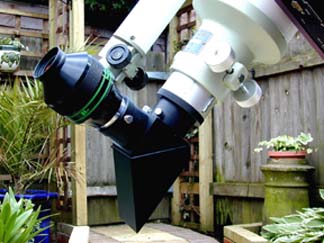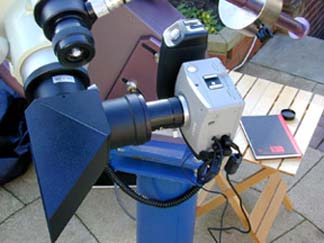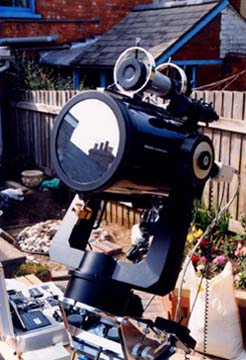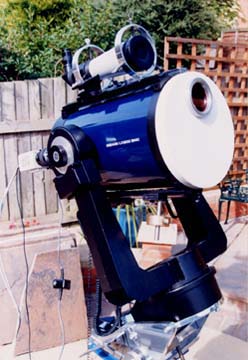Observing the Sun
- Our nearest Star
Sitting a modest 93
million miles from us, and with light taking only minutes to reach
us, our Sun gives us a great opportunity to see how a star really
behaves. To most people looking out on a warm summer's day the
sun seems a stable and calm globe. When we start to look in a
little more detail this so called stable globe is a mass of seething
gas, forever changing in its appearance. The blemish free surface
is not as blemish free as you would imagine. Many a feature can
be observed on its surface. Sunspots in particular provide fascinating
viewing. These cooler regions of the Sun appear dark as they are
not as hot as the background surface. Detail can be seen in their
shape and it is possible to watch them evolve over periods of
days, as they rotate across the face of the Sun. Sometimes regions
of white known as faculae can also be seen, and these can be very
short lived so that you can see these change over shorter periods.
A WARNING - ONLY OBSERVE
THE SUN USING EITHER THE PROJECTION METHOD, OR BUY SPECIAL FULL
APERTURE SOLAR FILTERS -
DO NOT USE THE FILTERS
OFTEN SUPPLIED WITH SMALL SCOPES WHICH FIT OVER THE EYEPIECE.
IT COULD BE THE LAST
THING YOU EVER SEE AS THE BACK OF YOUR EYE IS TURNED INTO A BLACK
MASS OF CONGEALED DEAD TISSUE - GET THE PICTURE !
Even regular solar
observers can make mistakes. Make sure your filter is secured
over the front of your scope, the wind can always blow the front
filter off. Users of a Herschel Wedge can easily forget the Polarising
filters when changing eyepieces.
All that aside the
Sun makes fascinating viewing. I use a Takahashi FS128 and FCT76
for most of my observing. I also use a Herschel Wedge for white
Light observation, this is not the safest means of observing,
but the quality of the image is considerably better than that
when viewed via a full aperture solar filter IMHO. The manufacture
is Intes and I rate this model very highly.
 . . . .
. . . .  Picture here is the
31mm Nagler in the Intes Herschel Wedge, and additionally in the
photographic mode with a 2x Barlow lens.
Picture here is the
31mm Nagler in the Intes Herschel Wedge, and additionally in the
photographic mode with a 2x Barlow lens.
 . . . . . . . .
. . . . . . . . Above is the LX200
10" with a full aperture solar mask, and in addition the
same instrument with an off axis mask, this time containing an
ERF for H alpha observations
To see examples of
my Solar observations click on the links below
Main
Solar Observing Page
Observations of the Sun in White Light
Observations of the Sun in H alpha
Total Solar Eclipse Observations
The
Transit of Mercury
Astronomy
Main.. Home
Above is the LX200
10" with a full aperture solar mask, and in addition the
same instrument with an off axis mask, this time containing an
ERF for H alpha observations
To see examples of
my Solar observations click on the links below
Main
Solar Observing Page
Observations of the Sun in White Light
Observations of the Sun in H alpha
Total Solar Eclipse Observations
The
Transit of Mercury
Astronomy
Main.. Home